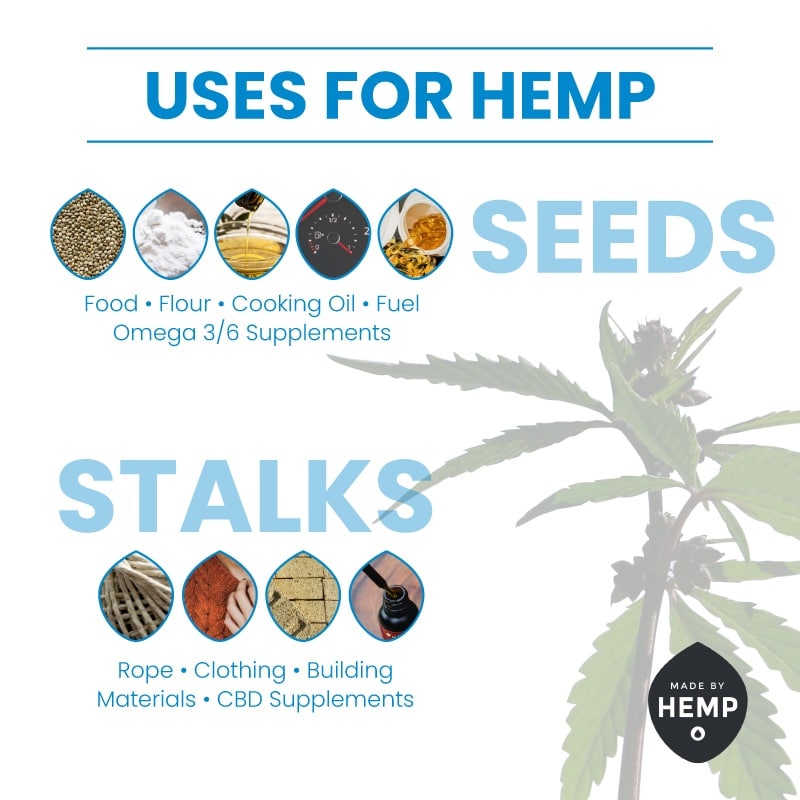Understanding Hemp Sustainability and its Impact on the Environment

One of the many advantages of hemp is its natural sustainability.
Over the last few decades, the effects of unsustainable practices have become more apparent than ever before. Accelerated climate change, inhuman working conditions, and a growing economic gap between countries are some of the biggest problems we face today.
By implementing sustainable farming and industrial techniques, we can help tackle these challenges and secure a better future for generations to come. But, to be successful, we need to find a feasible way to thrive from a social, environmental, and economic perspective.
This is where industrial hemp comes in.
Although it’s in the same family as marijuana, hemp is a harvest crop that doesn’t produce a psychoactive effect. This resilient plant can serve more than 2,500 purposes and it’s inherently sustainable, allowing us to overcome many of the hurdles associated with irresponsible farming and manufacturing.
Below, we’ve created a guide to hemp sustainability, where we will discuss the definition of industrial hemp and explain the impact it can have on the environment.
What is Hemp?
Before going over hemp sustainability, it’s important to understand a little bit more about this plant. As we mentioned before, industrial hemp is in the same family as marijuana. But, this crop doesn’t produce concentrated levels of THC, so it’s not consumed for recreational purposes.
For centuries, hemp has been used by dozens of different civilizations to produce fabrics and other goods. It has a fibrous material that’s similar to jute, which can be transformed into a variety of different products. It also has natural compounds called cannabinoids which can be used to make oils and other powerful supplements.
And, the best part is that hemp poses a much more sustainable alternative to cotton and other traditional crops.
Defining Sustainable Practices
In order to protect our natural resources and slow down climate change, we need to focus on implementing sustainable practices. The best way to describe this concept is through the three pillars of sustainability.
In this model, sustainability depends on three independent areas that are equally important. These are social, economic, and of course, environmental.
Social Implications
Sustainable practices ensure that global human rights are always being respected. This area covers topics like poverty, inequality, fair wages, social injustice, and other human rights matters. In order to achieve true sustainability, farming and industrial practices must always have a positive social impact.
Economic Effect
One of the major issues that have prevented the mass adopting of sustainable practice is its economic effect. The benefits of sustainability don’t always translate to rapid economic growth, which discourages many companies and lawmakers from focusing on this goal. Therefore, a sustainable model must fuel economic development to help encourage worldwide adoption.
Environmental Impact
When most people think about sustainability, they think of environmental impact right away, and with good reason. There is a finite amount of natural resources available on our planet. So, it’s important to manage them carefully to ensure our survival as a species.
Therefore, we need to adopt renewable energy, sustainable agriculture, and other approaches that produce less waste.
Understanding Why Hemp is Inherently Sustainable
Now that we’ve gone over the definition of sustainability, let’s discuss the reasons why hemp is inherently sustainable.
Returns Higher Amount of Nutrients to the Ground
Careless agricultural practices can extract nutrients without allowing the soil to replenish itself. This can result in soil degradation, which threatens the productivity and overall health of our food crops. Hemp is sustainable because it returns a significant percentage of nutrients back to the ground during the retting process. This results in healthier soil that can help slow erosion and keep our farmlands healthy for a longer period of time.
Uses Less Water than Traditional Crops
Cotton is used to produce almost one-third of all the textiles in the world. But, like many traditional crops, it requires a significant amount of water to grow healthy. Industrial hemp, on the other hand, needs less than one-third of the water, which puts less strain on our natural resources.
Produces Higher Yield from the Same Space
Hemp can grow in different types of soils and climates, but it also thrives in small spaces. Studies suggest that one acre of hemp can yield up to 8.7 tons under the right conditions. This allows farmers to decrease land usage without compromising their yield or finances. It also restores the soil’s health, food crops can be grown right after the hemp has been harvested.
Naturally Resistant to Pests, Diseases, and Fungus
The use of pesticides, fungicides, and similar chemicals can have a detrimental effect on the environment. Unlike most crops, hemp is extremely resilient and is naturally resistant to pests, fungi, and diseases, so farmers aren’t forced to use an excessive amount of chemicals on their crops.
Can Help Address Deforestation
Some estimates suggest that we are losing almost 19 million acres of rain forest every single year. A large portion of these rain forests is turned into agricultural land or harvested to make paper. Industrial hemp grows in small spaces, so it can slow down agricultural deforestation. Not only this, but this crop has a higher cellulose concentration than trees, so it can produce sturdier paper without the need to deplete our resources.
Suitable for Making Construction Materials, Clothing, Fuel, and More
Hemp is used in making thousands of various products. While you may be familiar with hemp fabric, the plant can be used to produce oils, soaps, paper, biofuel, and much more. You can also find hemp building materials, such as hempcrete, that allow you to reduce your home’s carbon emissions.
Hemp Grows Much Faster and Has a High-Profit Margin
Industrial hemp grows extremely quickly. Depending on the breed, some types of hemp are ready for fiber harvest in as little as 60 days. In comparison, trees used in paper production need to grow for 10 to 20 years before they can be turned into books and other goods.
Even though its become very popular for different reasons, hemp remains a profitable crop. Some reports suggest that the profit margins may be almost twice as high as staple crops like soy, making it a wise financial choice from all points of view.









In Mexico, they make straws out aguacate seed in about a 6 months decay in some towns it is against the Law to use plastic straws.